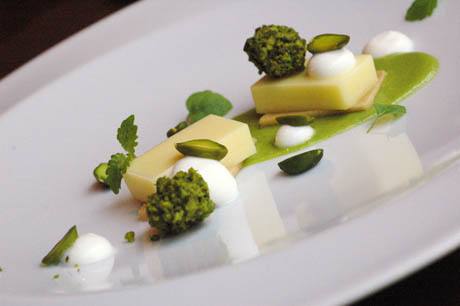
IMAGE: Albert Adrià’s falling chocolate trunk filled with frozen chocolate powder, on a forest floor of lime-and-mint yogurt, with almond praline, puffed quinoa, and green-pistachio streusel, via.
In this week’s New Yorker, Adam Gopnik has a lovely article about dessert. Writing as a lifelong dessert lover coming out of a year-long dessert-free diet, he finds a course in crisis.
Without surrendering sugar, dessert had surrendered all its familiar forms—the cake, the soufflé, the pudding—as the avant-garde novel had surrendered narrative, character, and moral. Losing our faith in art is, in a secular culture, what losing our faith in God was to a religious one; God only knows what losing our faith in desserts must be.
Gopnik skates over a quick history lesson, in which the primate instinct for sweetness meets the West Indies sugar plantation in the late seventeenth century. The ensuring “cheap-sugar revolution” simply spawned a nation of sweet tea drinkers in England, but inspired a “full-blown dessert cuisine” in France, whose culinary traditions then went on to become the fine dining template for the Western world.
But while this shorthand story more or less describes the evolution of dessert, it hardly provides a satisfactory explanation for the phenomenon. Or as White House pastry chef Bill Yosses asks Gopnik: “How did a whole way of cooking creep up from sweetness? Why do we use it to end the meal? Those are the big questions.”

IMAGE: Yuzu curd, shortbread, spruce yogurt, and pistachio, dessert by Alex Stupak. Photo by Antoinette Bruno.
Like dessert itself, the rest of the eight-page article provides little in the way of substantial answers, but much in the way of frivolous enjoyment. Gopnik talks with Alex Stupak, pastry chef at Wylie Dufresne’s WD-40, Jordi Butrón of Barcelona’s Espai-Sucre (“a working research laboratory and school, where new desserts are regularly conceived and experiments made”), Ferran and Albert Adrià of the now-shuttered elBulli, and “the young Mozart of pastry,” Jordi Roca, of another Catalonian temple to molecular gastronomy, El Celler de Can Roca.
Each of these men are wrestling with the very essence of dessert: what is it, and what could it be? Both Stupak and Butrón agree that dessert is an opportunity for the chef to create abstraction—to engineer an edible experience that delivers flavour and taste without the safety blanket of recognisable source ingredients. Butrón describes his work with a room full of pastry chefs, training in blindfolds, to develop “a catalogue of savours and flavours, which you can develop the way you develop muscles.” For Stupak, that sensory decoupling was exciting enough, conceptually, to make him become a pastry chef, even though he doesn’t even like sweets. As he tells Gopnik, with an expression the journalist characterises as “stern”:
Desserts are naturally denatured food. Birthday cake is the most denatured thing on earth.

IMAGE: Orange colourology by Jordi Roca, via.
Both Albert Adrià and Jordi Roca are younger brothers who work under their more famous older siblings (Ferran and Joan), and who seem to have arrived at the pastry chef job more by default than by choice, but have since embraced its infinite potential. Roca is best known for “colourology,” or single colour desserts, as well as desserts based on commercial perfumes, such as DKNY’s Be Delicious or Polo by Ralph Lauren:
That was something that hadn’t really been realised enough in desserts, I thought: the power of aromas. I went to Sephora and found the most wonderful aromas in all the women’s perfumes. And I started making desserts built around their smells.

IMAGE: Trésor by Lancôme, by Jordi Roca, via.
Meanwhile, Adrià wrestles with the line between sweet and savoury, creating edible illusions that blur and blend the two. He is perhaps best known for “a dessert of frozen time”—a dirt road in autumn made up of “cherry sorbet, salted honey yogurt, frozen chocolate powder, and spice bread.”
Charmingly, Adrià and Roca both share their most quixotic dessert fantasies with Gopnik. Albert dreams of hot ice cream (“You would look at it—ice cream—and then you would taste it, and it would be hot. Every year I thought I had it! But I never had it.”) while Jordi “wanted to make a dessert that would re-create the emotions that Lionel Messi feels when he scores a goal.”
But despite their evident pleasure in these inventive delights, the fundamental question of dessert remains a puzzle. Ferran Adrià admits that for all these talented pastry chefs’ experimentation with deconstruction, sweet versus savoury, and abstraction of flavour or scent, what really matters is sequence: “How do we finish the meal? With a surprise? A flourish? Reassurance?”

IMAGE: Dessert, as visualised by Wikipedia.
Interestingly, in a crowd-sourced complement to the epistemological crisis of the New Yorker’s avant-garde techno-emotional pastry chefs, Wikipedia’s dessert page is a inadequate and hotly contested stub. Clinging onto the weak assertions that dessert “usually” consists of sweet food, “typically” comes at the end of the meal, and is “often” eaten with a dessert spoon, the definition quickly fizzles out into a necessarily incomplete list of possible dessert dishes and a half-hearted admission of dessert’s essential superfluity (“Elimination of dessert foods may be a strategy used in dieting.”).
Over at the associated editing page, conversation is heated, with comments such as “Pudding is not a dessert,” “I don’t think that “Dessert” really belongs in the “Meal” series,” and “WHY DOES AS IMPORTANT A THING AS DESSERT GET SUCH A STUB AS THIS!!” Class conflict even rears its ugly head, with some claiming that the exemplary dessert photo is “upper-class bias, people!” while others quibble that the very word “dessert” is elitist.
In its own way, dessert seems to me to be the poetry of food: elusive except by self-definition, best in small servings, and with a tendency to abstraction, it is easily dispensed with altogether, but also has the power to evoke sensation and emotion like no other form. At the very least, it’s a fun excuse to order it more often in 2011.

